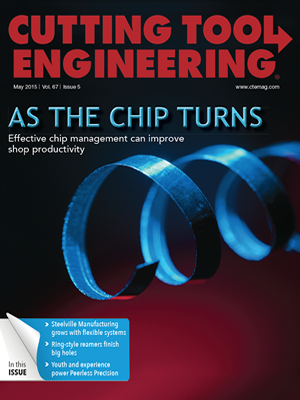My first shop job was shoveling brass chips from the tail end of an Acme Gridley screw machine. Each afternoon I went home with my pants reeking of sulfur-based oil, my legs covered in rashes and my 16-year old back afire from hauling 55-gal. drums of oily swarf. I lasted 2 weeks.
Of course, that wasn’t the last time I shoveled out a chip pan. In a machine shop, dealing with chips is part of the job. But chip management shouldn’t mean oily clothes, skin rashes and cut fingers. Manufacturers of material handling equipment offer many different solutions to tame pesky chips, preserve the environment and improve profitability.
Magnetic Personality
There are many reasons to invest in a chip management system. The first is uptime. Every minute an operator spends with a shovel in his hand is a minute he isn’t checking tools or loading parts. The first line of defense in this case is a scrap conveyor, which removes machining waste from a machine tool to a drum or wheeled bin for transport, while giving the shovel an early retirement.
Don Suderman, material handling product manager for Bunting Magnetics Co., Newton, Kan., said scrap conveyors aren’t optional. “Unless you need the exercise or have the extra manpower, there are easier and more economical ways of handling scrap steel than moving it with a shovel.”
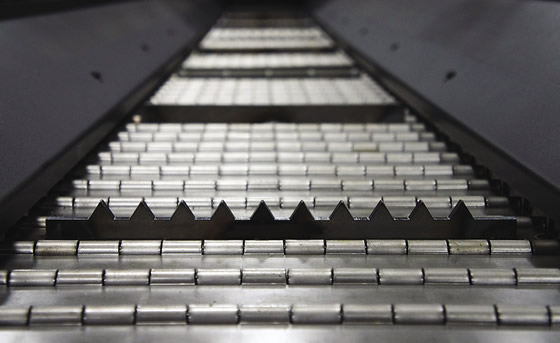
The sawtooth edge on a hinged-belt conveyor helps grab stringy chips and pull them out of a machine. Image courtesy Hennig.
For shops that primarily machine ferrous materials, magnetic conveyors are commonly method of chip disposal. They use a series of rare earth or ceramic magnets mounted beneath a stainless steel conveyor belt to pull scrap up an incline. At the top, the magnets retract to release the scrap, which falls into a waste bin or another conveyor system.
Suderman said magnetic conveyors have no external moving parts, making them relatively jam-proof. By running the conveyor at a low speed, much of the cutting fluid that would otherwise be carried with the chips drains back into the machine. A basic system starts at around $10,000.
But why bother? Scrap steel and iron isn’t worth very much—a pound of clean, dry chips fetches only 35 to 65 cents from a dealer. But in today’s green world, keeping waste out of the landfill is important. According to the American Iron and Steel Institute, steel is the world 's most recycled material and suffers no degradation with repeated processing.
Hinged for Success
Machine protection provider Hennig Inc., Machesney Park, Ill., also makes and sells conveyors. Scott Cooley, chip conveyor and filtration system business manager, said the company offers several flavors, including magnetic conveyors, scraper-type conveyors for cast iron, bronze and brass machining, and general-purpose, hinge-style ones. Of these, hinged conveyors account for 90 percent of Hennig’s conveyor sales.
“Job shops might cut Inconel one day, brass or aluminum the next,” Cooley said. “In this situation, a hinged conveyor works best. It can handle long, stringy chips from stainless steel machining, very fine chips from cast iron machining and anything in between.”
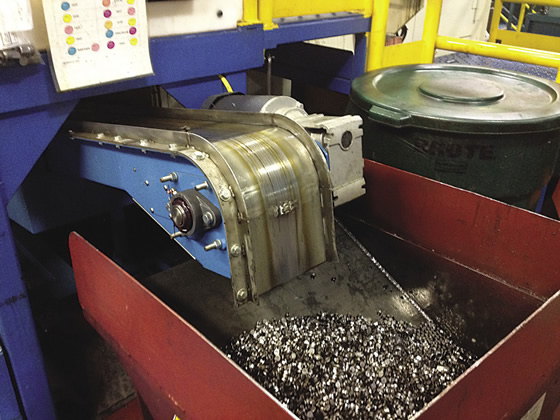
A MagSlide conveyor can carry more than chips. In this application, fasteners are removed from a cold heading machine. Image courtesy Bunting Magnetics.
As the name implies, hinged conveyors use a cleated steel belt that looks like the tread on a battle tank to grab chips and carry them out of the machining area. Like a tank, the belt is rugged and handles heavy loads.
Conveyors can be equipped to do more than move chips. Small metal fines can plug high-pressure coolant systems and damage pumps, while tramp oil eventually turns even the most pristine machine sump into a swampy mess. To combat these problems, Cooley recommends a chip disc-filtration system, an integrated hinged or scraper belt conveyor that includes disc-style permanent media filters, high- and low-pressure pumps and an inline oil skimmer. System cost ranges from $15,000 to $35,000, depending on the configuration.
Spinning Wheel
That may seem like a lot of money, but without clean cutting fluid, tool life and part quality suffer. Mike Hook, responsible for North American sales at chip and fluid management systems manufacturer PRAB Inc., Kalamazoo, Mich., said the cutting fluid aspect of chip management is frequently overlooked. “Before you send a dumpster full of wet or oily chips down the road, consider the cost of those cutting fluids, as well as the environmental impact of not recycling them.”
This is especially true with cutting oils, which can run $20 or more per gallon—10 to 20 times the cost of water-soluble cutting fluids. For heavy users of cutting oil, such as Swiss-style CNC shops and screw machine houses, this can mean big bucks. Recycling a ton of brass chips contaminated with just 5 percent by weight of oil could mean a loss of $5,000. Likewise, shops that generate a dumpster’s worth of aluminum chips each week may lose comparable amounts of money in water-based cutting fluid.
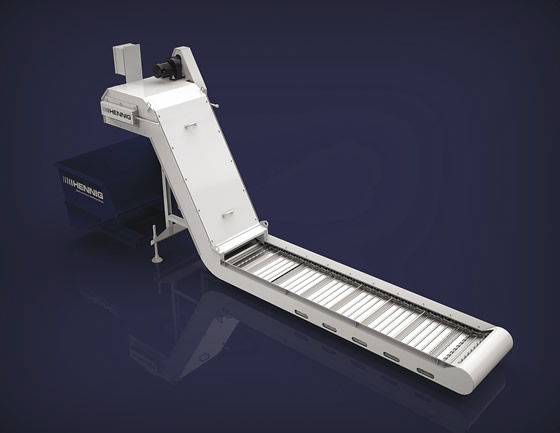
A hinged chip conveyor from Hennig. Image courtesy Hennig.
One solution is spinning. Centrifuges are the metal equivalent of heavy-duty salad spinners; they quickly turn wet chips into dry ones. Some shops keep it simple: Fill the chip carts on a regular schedule, pull them to a central processing system, dump them in the hopper and push the button. “There’s some manual labor involved, but it’s minimal,” Hook said. The alternative is an automated system that conveys the chips to the processing unit. Depending on the shop, this can cost $100,000 to $1 million or more.
While costly, payback for a shop with a few dozen machines running 24/7 can be relatively quick—6 months—or much longer—up to 6 years—depending on the materials being recovered, the volumes and the initial investment. The payback comes from significantly reducing coolant loss and generating clean, dry chips that bring a premium price.
“If you look at what chip management costs in terms of labor and downtime, it doesn 't take long to justify some automation,” Hook said. “Every minute spent manually cleaning a chip tank or wrangling chips into a scrap bin costs money. Also, the cost of fluid handling can quickly add up. That’s why it’s important to select a chip management system that not only dries the chips but recovers and recycles cutting fluids to like-new condition.”
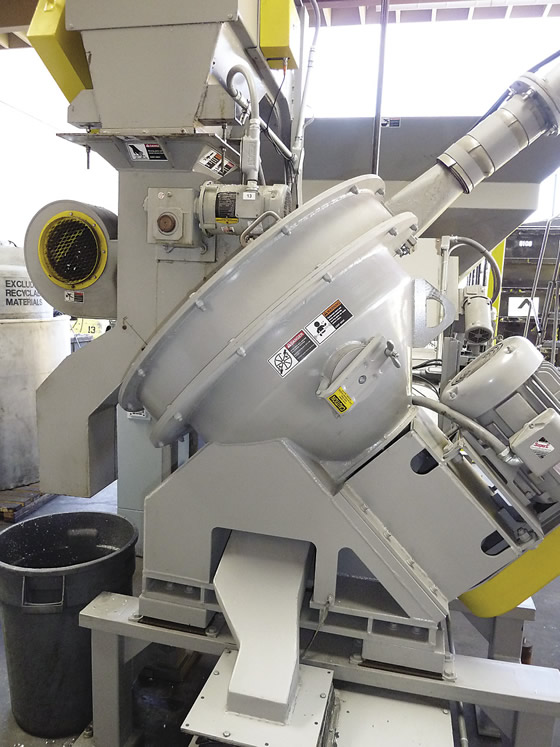
A PRAB shredder and wringer combination unit reduces bushy wads of metal and separates fluids.
It’s much easier to design a shop for an automated scrap handling system than it is to retrofit one. Trough-style conveyors are an effective way to transport chips for processing, but may require extensive concrete cutting and remodeling. And environmental concerns over leaks and groundwater contamination are making some companies look towards the ceiling, with overhead conveyors, rather than down at the floor for chip management. “In-floor systems seem to be getting fewer and farther between,” said Ed Zeitz, sales engineer at Mayfran International Inc., Cleveland.
Instead, many shops opt for vacuuming chips to a central location or “pump backs” that use coolant to flush the chips to a holding tank for processing. Whichever way you go, stringy chips can create problems. Applying cutting tools with chipbreakers help, but some chips still don’t behave. For this situation, shredders are needed. “Auto-makers use these on their crank and camshaft lines,” Zeitz said. “The other option is a cutter pump, which breaks up small strings and allows them to be move through the recycling system.”
Throw On Some Briquettes
Another consideration is volume, especially for light, fluffy chips, such as aluminum and zinc ones, or for shops in rural areas where the scrap man might have to drive long distances. For these chip producers, minimizing the size of their machining waste brings maximum value.
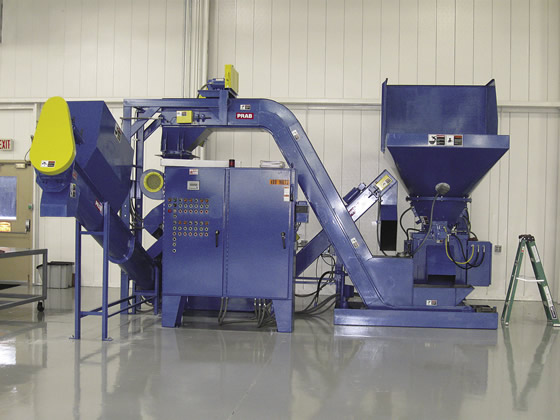
A complete, automated chip processing system from PRAB includes volume reduction, a shredder, a centrifuge and conveyors. Image courtesy PRAB.
“We have a customer in Iowa that machines a lot of aluminum,” Zeitz said. “Due to their large chip volumes, and because the scrap hauler was charging a fee for every pickup, the company invested in a system that shreds and compacts the material into briquettes.”
Depending on the briquetter, compacted aluminum briquettes weigh around 125 lbs./cu. ft. and are nearly 10 times denser than loose chips, saving considerable storage space. And scrap dealers sometimes pay two to three times as much for briquettes compared to noncompacted material.
Mixing it Up
All of this is good news for the shop making lots of aluminum aircraft components annually or the Tier 2 automotive supplier cutting trainloads of engine blocks. But for the typical job shop, there’s less joy here. High-tech automated systems are designed to efficiently process a single material. Switching a chip management system from one material to another means extensive cleaning to prevent cross-contamination. Yet many mom-and-pop shops machine dozens of different materials every week, and no one has yet invented a cost-effective way to separate, for example, stainless steel chips from brass ones.
That’s not to say chip management is a lost cause for smaller shops. Chip conveyors are still a good investment, reducing the time needed to shovel out the chip pan, improving efficiency and worker disposition. Clever job scheduling and dedicating machines to certain materials minimizes contamination, thus increasing the price received from the scrap man. And medium-size shops with a dozen or so machines running common materials may benefit from centrifuges and briquetting systems. Whatever the solution, it’s time to get rid of those shovels. They’re a real backbreaker. CTE
About the Author: Kip Hanson is contributing editor for CTE. Contact him at (520) 548-7328 or [email protected].
Keep the carbide here
Only 5 percent of the world’s reserves of tungsten ore−the primary ingredient of cemented carbide cutting tools−are in the U.S. Some reserves are located in Russia, Canada and other countries, but China holds 60 percent of the planet’s tungsten reserves, according to the U.S. Geological Survey. Bill Walter, president of carbide recovery firm Carbide-USA, Elmira, N.Y., said this is a darned good reason to recycle carbide in the U.S. “The Chinese already have most of the ore. Domestic recycling gives us more raw material to work with at home.”
Carbide-USA quotes recycled carbide and accepts shipments of carbide scrap materials that weigh under 70 lbs. (31.8 kg). It also accepts carbide sludge from oil- and water-based coolant filtration systems, as well as cartridge-type filters. Carbide sludge is typically shipped to Carbide-USA in barrels.
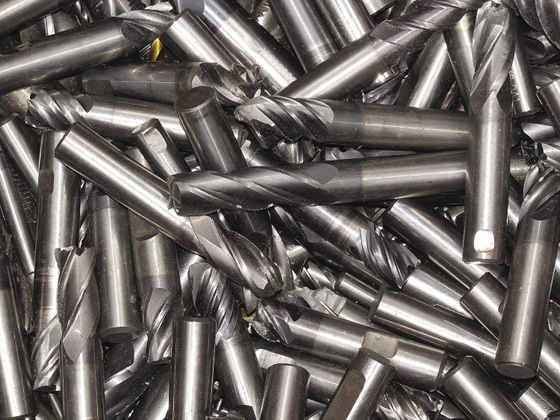
Broken and worn carbide endmills are ready for recycling. Image courtesy Carbide-USA.
Cemented carbide is tough stuff. For those wondering about the monstrously powerful process used to mash scrap inserts and endmills into tungsten powder, it’s not that exciting. It 's called zinc processing and works when graphite “boats” are loaded with scrap carbide, then filled with molten zinc. The carbide gradually swells like a marshmallow over a campfire, leaving a porous cake that is ground into tungsten-cobalt powder, suitable for blending with virgin tungsten.
The other recycling process is electrochemical and breaks cemented carbide into its constituent components. It’s a bit more complex, but yields tungsten powder indistinguishable from its original form. “It becomes virgin material again,” Walter said. “You can use it to create anything−endmills, drills, inserts, whatever. It’s more expensive than zinc recycling, but gives you greater flexibility with the product.”
Whatever the extraction process, Walter said there needs to be greater effort towards recycling. “At current rates, shops can get around $8 per lb. or more for clean scrap carbide, but most figures show recycling rates at only 35 percent. It needs to be much higher. It’s good for the environment and, provided we keep it here, good for the U.S. as well.”
—K. Hanson
Contributors
Bunting Magnetics Co.
(800) 835-2526
www.buntingmagnetics.com
Carbide-USA
(607) 331-9353
www.carbide-usa.com
Hennig Inc.
(888) 436-6446
www.hennigworldwide.com
Mayfran International Inc.
(440) 461-4100
www.mayfran.com
PRAB Inc.
(800) 968-7722
www.prab.com
Related Glossary Terms
- centrifuge
centrifuge
Filtering device that uses a spinning bowl and the differences in specific gravities of materials to separate one from another. A centrifuge can be used to separate loosely emulsified and free oils from water-diluted metalworking fluid mixes and to remove metalworking fluids from chips.
- computer numerical control ( CNC)
computer numerical control ( CNC)
Microprocessor-based controller dedicated to a machine tool that permits the creation or modification of parts. Programmed numerical control activates the machine’s servos and spindle drives and controls the various machining operations. See DNC, direct numerical control; NC, numerical control.
- coolant
coolant
Fluid that reduces temperature buildup at the tool/workpiece interface during machining. Normally takes the form of a liquid such as soluble or chemical mixtures (semisynthetic, synthetic) but can be pressurized air or other gas. Because of water’s ability to absorb great quantities of heat, it is widely used as a coolant and vehicle for various cutting compounds, with the water-to-compound ratio varying with the machining task. See cutting fluid; semisynthetic cutting fluid; soluble-oil cutting fluid; synthetic cutting fluid.
- cutting fluid
cutting fluid
Liquid used to improve workpiece machinability, enhance tool life, flush out chips and machining debris, and cool the workpiece and tool. Three basic types are: straight oils; soluble oils, which emulsify in water; and synthetic fluids, which are water-based chemical solutions having no oil. See coolant; semisynthetic cutting fluid; soluble-oil cutting fluid; synthetic cutting fluid.
- lapping compound( powder)
lapping compound( powder)
Light, abrasive material used for finishing a surface.
- recovery
recovery
Reduction or removal of workhardening effects, without motion of large-angle grain boundaries.
- swarf
swarf
Metal fines and grinding wheel particles generated during grinding.
- tramp oil
tramp oil
Oil that is present in a metalworking fluid mix that is not from the product concentrate. The usual sources are machine tool lubrication system leaks.


